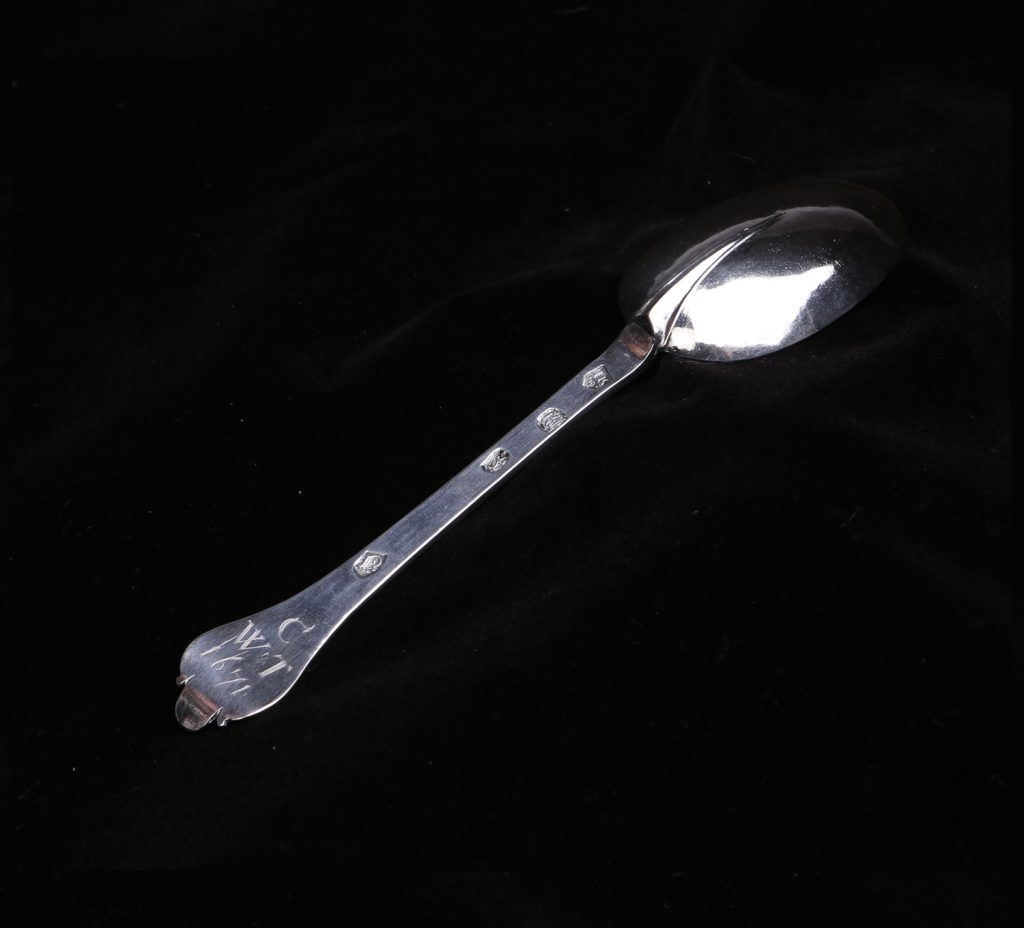Historic and Hallmarked Silver
Hallmarks and makers’ marks are official marks stamped on gold and silver objects to attest to their purity and authenticity. These distinguishing marks are represented in symbols, letters, or numbers and can also indicate where the piece was made, the period, and whether tax was paid on the silver.
Hallmarked pieces by renowned silversmiths Paul Storr, Samuel Neville, and Mackay and Chisholm are also on display.
During the Gilded Age in America, from after the Civil War until the turn of the 20th century, when the fortunes of the Vanderbilts, the Morgans, the Astors, and others were being made and spent, it was commonplace for these wealthy American families to adorn their tables with the many different kinds of flatware for the various elaborate courses that would be part of an evening meal.

[Sterling Silver Dog Nose Spoon with Stylized Rattail]
London, 1670
Vanderbilt University Silver Collection
The Dog Nose spoon is the oldest object in this exhibit. Its hallmark, an “N” within a shield, dates precisely to 1670, and the initials engraving on the handle, to celebrate a wedding in 1671, is contemporaneous with the making of this piece.
![[Sterling Silver Tea Caddy]](https://exhibitions.library.vanderbilt.edu/silver-and-gold/wp-content/uploads/sites/73/2023/06/20180604AR0047-1500-1019x1024.jpg)
[Sterling Silver Tea Caddy]
Peter, Ann, and William Bateman
London, 1802
Vanderbilt University Silver Collection
The hallmarks on the bottom of the oval tea caddy tell us that this sterling silver object was made by members of the Bateman family, Peter, Ann, and William, all children of Hester Bateman who was one of the most important silversmiths in Great Britain during the late 18th and early 19th centuries.
![[Sterling Silver Dog Nose Spoon with Stylized Rattail]](https://exhibitions.library.vanderbilt.edu/silver-and-gold/wp-content/uploads/sites/73/2023/08/48-1500-1024x637.jpg)
[Sterling Silver Double Marrow Scoop]
Ebenezer Coker
London, 1750
Vanderbilt University Silver Collection
![[Sterling Silver Tea Strainer, Francis I Pattern]](https://exhibitions.library.vanderbilt.edu/silver-and-gold/wp-content/uploads/sites/73/2023/06/20180604AR0080-1500-1024x928.jpg)
[Sterling Silver Tea Strainer, Francis I Pattern]
Reed and Barton
Taunton, Massachusetts, circa mid-20th Century
Vanderbilt University Silver Collection
![[Sterling Silver Large Crested Serving Spoon, Coat of Arms Unknown]](https://exhibitions.library.vanderbilt.edu/silver-and-gold/wp-content/uploads/sites/73/2023/08/41-1500-1024x645.jpg)
[Sterling Silver Large Crested Serving Spoon, Coat of Arms Unknown]
Paul Storr
London, circa 1810
Vanderbilt University Silver Collection
![[Sterling Silver Master Salt Spoon, Scottish King’s Pattern]](https://exhibitions.library.vanderbilt.edu/silver-and-gold/wp-content/uploads/sites/73/2023/08/13-1500-1024x599.jpg)
[Sterling Silver Master Salt Spoon, Scottish King’s Pattern]
MacKay and Chisholm
Edinburgh, 1850
Vanderbilt University Silver Collection
![[Sterling Silver Crested Dessert Fork, Coat of Arms Unknown]](https://exhibitions.library.vanderbilt.edu/silver-and-gold/wp-content/uploads/sites/73/2023/06/20180604AR0130-1500-1024x928.jpg)
[Sterling Silver Crested Dessert Fork, Coat of Arms Unknown]
Samuel Neville
Dublin, 1834
Vanderbilt University Silver Collection
